Analysis of Contemporary Business Economics Concepts and Theories
VerifiedAdded on 2023/01/12
|13
|3192
|66
Report
AI Summary
This report provides a comprehensive analysis of contemporary business economics, focusing on microeconomic concepts and comparing economic theories across different eras. Task 1 delves into the laws of demand and supply, examining their impact on the retail sector, specifically using M&S as a case study. It explores movements along demand and supply curves and the factors influencing shifts in these curves, supported by relevant diagrams. Task 2 compares and contrasts emerging theories and models in 21st-century economics with those of the 20th century, relating both to modern business practices. The report highlights how globalization, technology, and diversity have reshaped business environments. The analysis emphasizes the importance of adaptability and understanding economic principles for effective decision-making in today's dynamic business landscape.
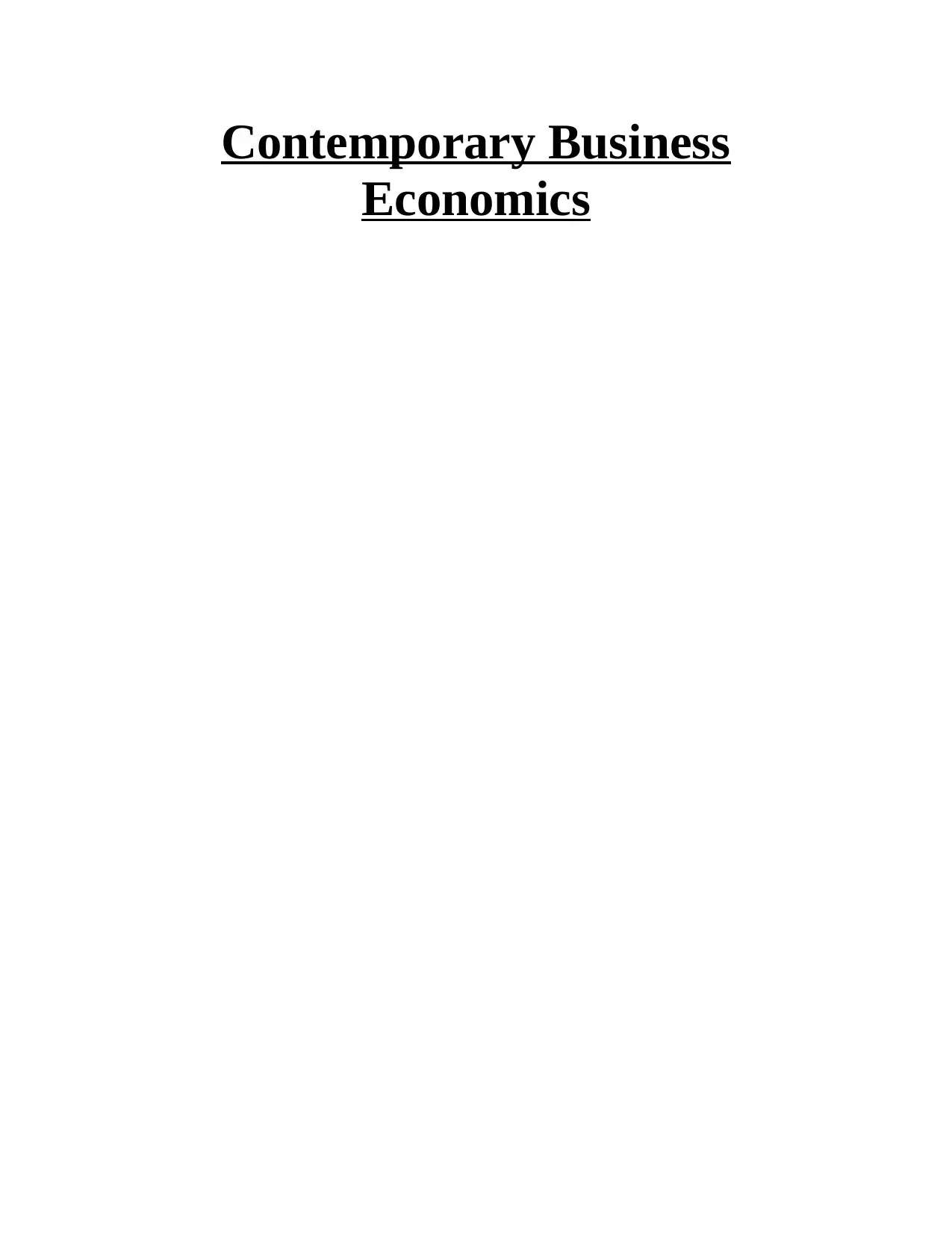
Contemporary Business
Economics
Economics
Paraphrase This Document
Need a fresh take? Get an instant paraphrase of this document with our AI Paraphraser

Table of Contents
INTRODUCTION...........................................................................................................................1
TASK 1............................................................................................................................................1
1.1 Law of demand and changes in demand curve with its factors.............................................1
1.2 Law of Supply and changes in supply curve with its factors................................................4
TASK 2............................................................................................................................................6
Compare and contrast of 21st emerging theories with 20th contemporary economics.................6
CONCLUSION................................................................................................................................9
REFERENCES..............................................................................................................................10
INTRODUCTION...........................................................................................................................1
TASK 1............................................................................................................................................1
1.1 Law of demand and changes in demand curve with its factors.............................................1
1.2 Law of Supply and changes in supply curve with its factors................................................4
TASK 2............................................................................................................................................6
Compare and contrast of 21st emerging theories with 20th contemporary economics.................6
CONCLUSION................................................................................................................................9
REFERENCES..............................................................................................................................10

⊘ This is a preview!⊘
Do you want full access?
Subscribe today to unlock all pages.

Trusted by 1+ million students worldwide
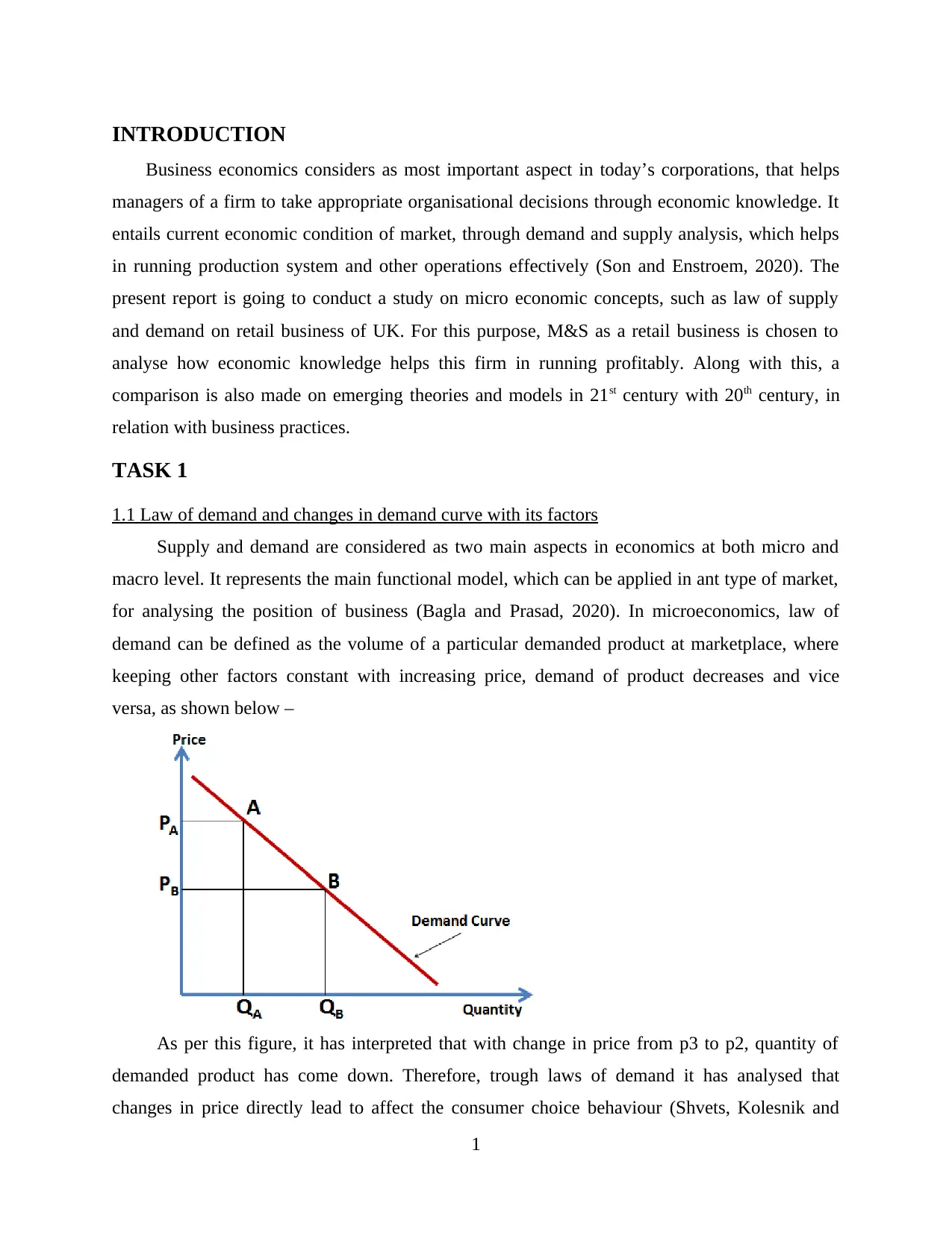
INTRODUCTION
Business economics considers as most important aspect in today’s corporations, that helps
managers of a firm to take appropriate organisational decisions through economic knowledge. It
entails current economic condition of market, through demand and supply analysis, which helps
in running production system and other operations effectively (Son and Enstroem, 2020). The
present report is going to conduct a study on micro economic concepts, such as law of supply
and demand on retail business of UK. For this purpose, M&S as a retail business is chosen to
analyse how economic knowledge helps this firm in running profitably. Along with this, a
comparison is also made on emerging theories and models in 21st century with 20th century, in
relation with business practices.
TASK 1
1.1 Law of demand and changes in demand curve with its factors
Supply and demand are considered as two main aspects in economics at both micro and
macro level. It represents the main functional model, which can be applied in ant type of market,
for analysing the position of business (Bagla and Prasad, 2020). In microeconomics, law of
demand can be defined as the volume of a particular demanded product at marketplace, where
keeping other factors constant with increasing price, demand of product decreases and vice
versa, as shown below –
As per this figure, it has interpreted that with change in price from p3 to p2, quantity of
demanded product has come down. Therefore, trough laws of demand it has analysed that
changes in price directly lead to affect the consumer choice behaviour (Shvets, Kolesnik and
1
Business economics considers as most important aspect in today’s corporations, that helps
managers of a firm to take appropriate organisational decisions through economic knowledge. It
entails current economic condition of market, through demand and supply analysis, which helps
in running production system and other operations effectively (Son and Enstroem, 2020). The
present report is going to conduct a study on micro economic concepts, such as law of supply
and demand on retail business of UK. For this purpose, M&S as a retail business is chosen to
analyse how economic knowledge helps this firm in running profitably. Along with this, a
comparison is also made on emerging theories and models in 21st century with 20th century, in
relation with business practices.
TASK 1
1.1 Law of demand and changes in demand curve with its factors
Supply and demand are considered as two main aspects in economics at both micro and
macro level. It represents the main functional model, which can be applied in ant type of market,
for analysing the position of business (Bagla and Prasad, 2020). In microeconomics, law of
demand can be defined as the volume of a particular demanded product at marketplace, where
keeping other factors constant with increasing price, demand of product decreases and vice
versa, as shown below –
As per this figure, it has interpreted that with change in price from p3 to p2, quantity of
demanded product has come down. Therefore, trough laws of demand it has analysed that
changes in price directly lead to affect the consumer choice behaviour (Shvets, Kolesnik and
1
Paraphrase This Document
Need a fresh take? Get an instant paraphrase of this document with our AI Paraphraser
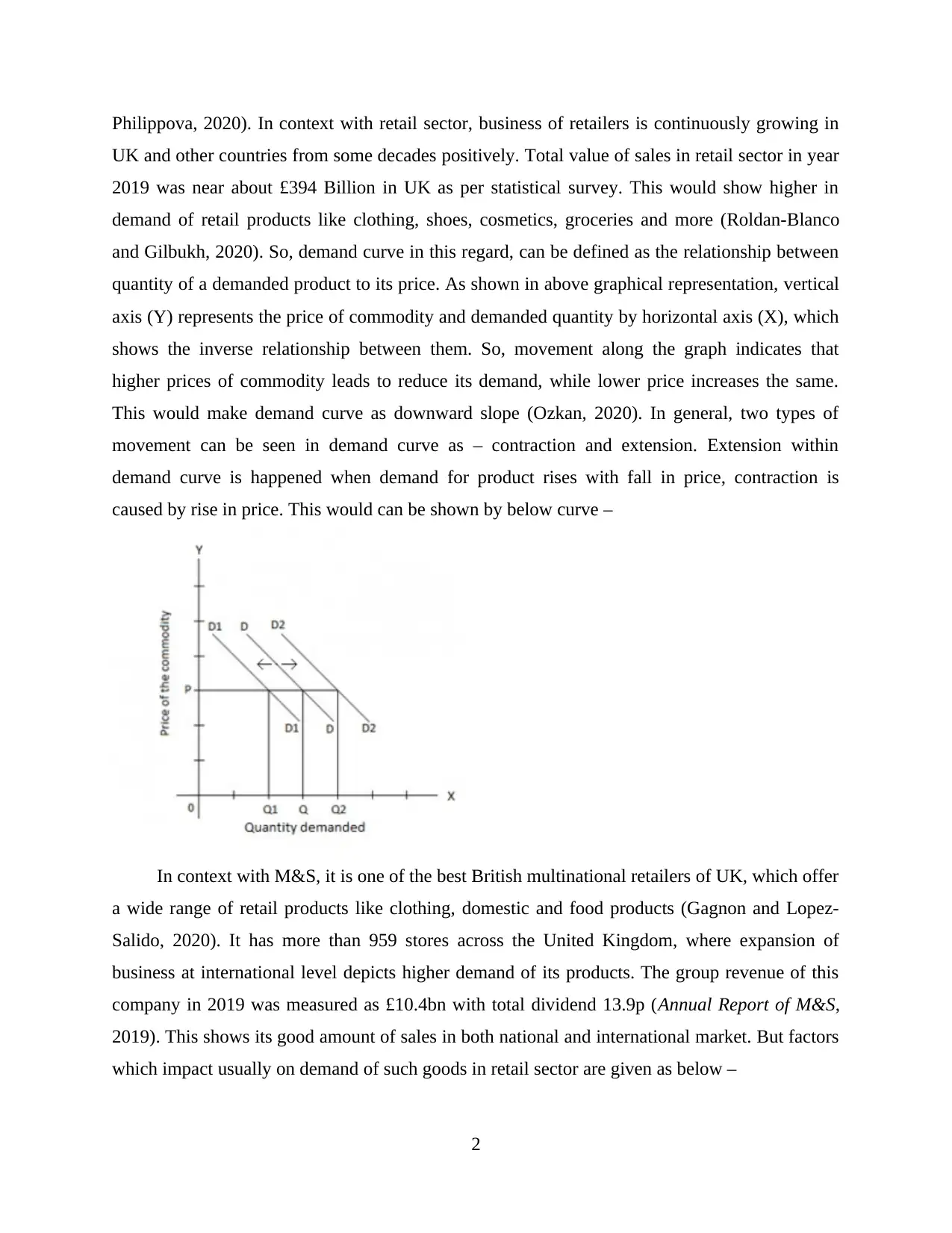
Philippova, 2020). In context with retail sector, business of retailers is continuously growing in
UK and other countries from some decades positively. Total value of sales in retail sector in year
2019 was near about £394 Billion in UK as per statistical survey. This would show higher in
demand of retail products like clothing, shoes, cosmetics, groceries and more (Roldan-Blanco
and Gilbukh, 2020). So, demand curve in this regard, can be defined as the relationship between
quantity of a demanded product to its price. As shown in above graphical representation, vertical
axis (Y) represents the price of commodity and demanded quantity by horizontal axis (X), which
shows the inverse relationship between them. So, movement along the graph indicates that
higher prices of commodity leads to reduce its demand, while lower price increases the same.
This would make demand curve as downward slope (Ozkan, 2020). In general, two types of
movement can be seen in demand curve as – contraction and extension. Extension within
demand curve is happened when demand for product rises with fall in price, contraction is
caused by rise in price. This would can be shown by below curve –
In context with M&S, it is one of the best British multinational retailers of UK, which offer
a wide range of retail products like clothing, domestic and food products (Gagnon and Lopez-
Salido, 2020). It has more than 959 stores across the United Kingdom, where expansion of
business at international level depicts higher demand of its products. The group revenue of this
company in 2019 was measured as £10.4bn with total dividend 13.9p (Annual Report of M&S,
2019). This shows its good amount of sales in both national and international market. But factors
which impact usually on demand of such goods in retail sector are given as below –
2
UK and other countries from some decades positively. Total value of sales in retail sector in year
2019 was near about £394 Billion in UK as per statistical survey. This would show higher in
demand of retail products like clothing, shoes, cosmetics, groceries and more (Roldan-Blanco
and Gilbukh, 2020). So, demand curve in this regard, can be defined as the relationship between
quantity of a demanded product to its price. As shown in above graphical representation, vertical
axis (Y) represents the price of commodity and demanded quantity by horizontal axis (X), which
shows the inverse relationship between them. So, movement along the graph indicates that
higher prices of commodity leads to reduce its demand, while lower price increases the same.
This would make demand curve as downward slope (Ozkan, 2020). In general, two types of
movement can be seen in demand curve as – contraction and extension. Extension within
demand curve is happened when demand for product rises with fall in price, contraction is
caused by rise in price. This would can be shown by below curve –
In context with M&S, it is one of the best British multinational retailers of UK, which offer
a wide range of retail products like clothing, domestic and food products (Gagnon and Lopez-
Salido, 2020). It has more than 959 stores across the United Kingdom, where expansion of
business at international level depicts higher demand of its products. The group revenue of this
company in 2019 was measured as £10.4bn with total dividend 13.9p (Annual Report of M&S,
2019). This shows its good amount of sales in both national and international market. But factors
which impact usually on demand of such goods in retail sector are given as below –
2
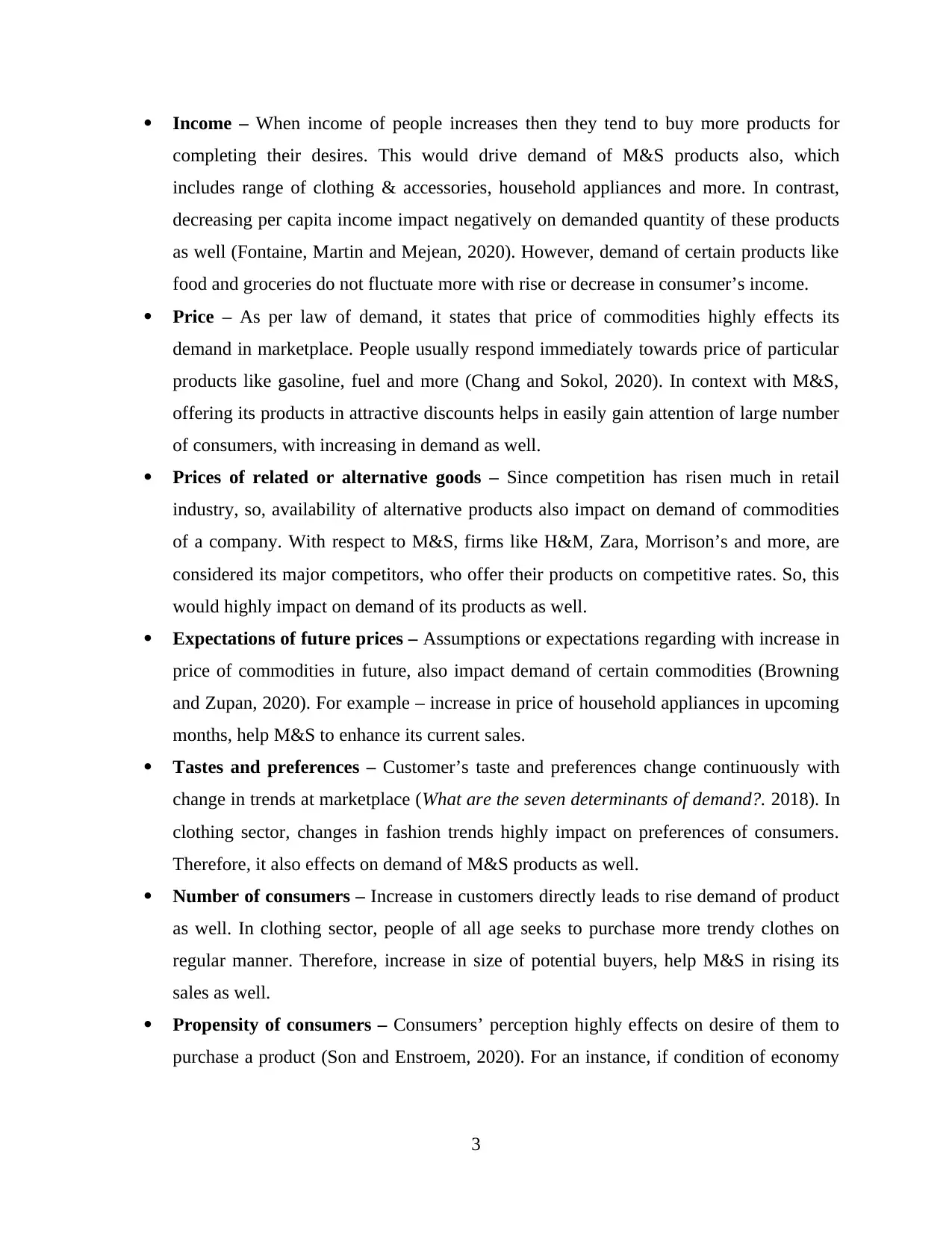
Income – When income of people increases then they tend to buy more products for
completing their desires. This would drive demand of M&S products also, which
includes range of clothing & accessories, household appliances and more. In contrast,
decreasing per capita income impact negatively on demanded quantity of these products
as well (Fontaine, Martin and Mejean, 2020). However, demand of certain products like
food and groceries do not fluctuate more with rise or decrease in consumer’s income.
Price – As per law of demand, it states that price of commodities highly effects its
demand in marketplace. People usually respond immediately towards price of particular
products like gasoline, fuel and more (Chang and Sokol, 2020). In context with M&S,
offering its products in attractive discounts helps in easily gain attention of large number
of consumers, with increasing in demand as well.
Prices of related or alternative goods – Since competition has risen much in retail
industry, so, availability of alternative products also impact on demand of commodities
of a company. With respect to M&S, firms like H&M, Zara, Morrison’s and more, are
considered its major competitors, who offer their products on competitive rates. So, this
would highly impact on demand of its products as well.
Expectations of future prices – Assumptions or expectations regarding with increase in
price of commodities in future, also impact demand of certain commodities (Browning
and Zupan, 2020). For example – increase in price of household appliances in upcoming
months, help M&S to enhance its current sales.
Tastes and preferences – Customer’s taste and preferences change continuously with
change in trends at marketplace (What are the seven determinants of demand?. 2018). In
clothing sector, changes in fashion trends highly impact on preferences of consumers.
Therefore, it also effects on demand of M&S products as well.
Number of consumers – Increase in customers directly leads to rise demand of product
as well. In clothing sector, people of all age seeks to purchase more trendy clothes on
regular manner. Therefore, increase in size of potential buyers, help M&S in rising its
sales as well.
Propensity of consumers – Consumers’ perception highly effects on desire of them to
purchase a product (Son and Enstroem, 2020). For an instance, if condition of economy
3
completing their desires. This would drive demand of M&S products also, which
includes range of clothing & accessories, household appliances and more. In contrast,
decreasing per capita income impact negatively on demanded quantity of these products
as well (Fontaine, Martin and Mejean, 2020). However, demand of certain products like
food and groceries do not fluctuate more with rise or decrease in consumer’s income.
Price – As per law of demand, it states that price of commodities highly effects its
demand in marketplace. People usually respond immediately towards price of particular
products like gasoline, fuel and more (Chang and Sokol, 2020). In context with M&S,
offering its products in attractive discounts helps in easily gain attention of large number
of consumers, with increasing in demand as well.
Prices of related or alternative goods – Since competition has risen much in retail
industry, so, availability of alternative products also impact on demand of commodities
of a company. With respect to M&S, firms like H&M, Zara, Morrison’s and more, are
considered its major competitors, who offer their products on competitive rates. So, this
would highly impact on demand of its products as well.
Expectations of future prices – Assumptions or expectations regarding with increase in
price of commodities in future, also impact demand of certain commodities (Browning
and Zupan, 2020). For example – increase in price of household appliances in upcoming
months, help M&S to enhance its current sales.
Tastes and preferences – Customer’s taste and preferences change continuously with
change in trends at marketplace (What are the seven determinants of demand?. 2018). In
clothing sector, changes in fashion trends highly impact on preferences of consumers.
Therefore, it also effects on demand of M&S products as well.
Number of consumers – Increase in customers directly leads to rise demand of product
as well. In clothing sector, people of all age seeks to purchase more trendy clothes on
regular manner. Therefore, increase in size of potential buyers, help M&S in rising its
sales as well.
Propensity of consumers – Consumers’ perception highly effects on desire of them to
purchase a product (Son and Enstroem, 2020). For an instance, if condition of economy
3
⊘ This is a preview!⊘
Do you want full access?
Subscribe today to unlock all pages.

Trusted by 1+ million students worldwide
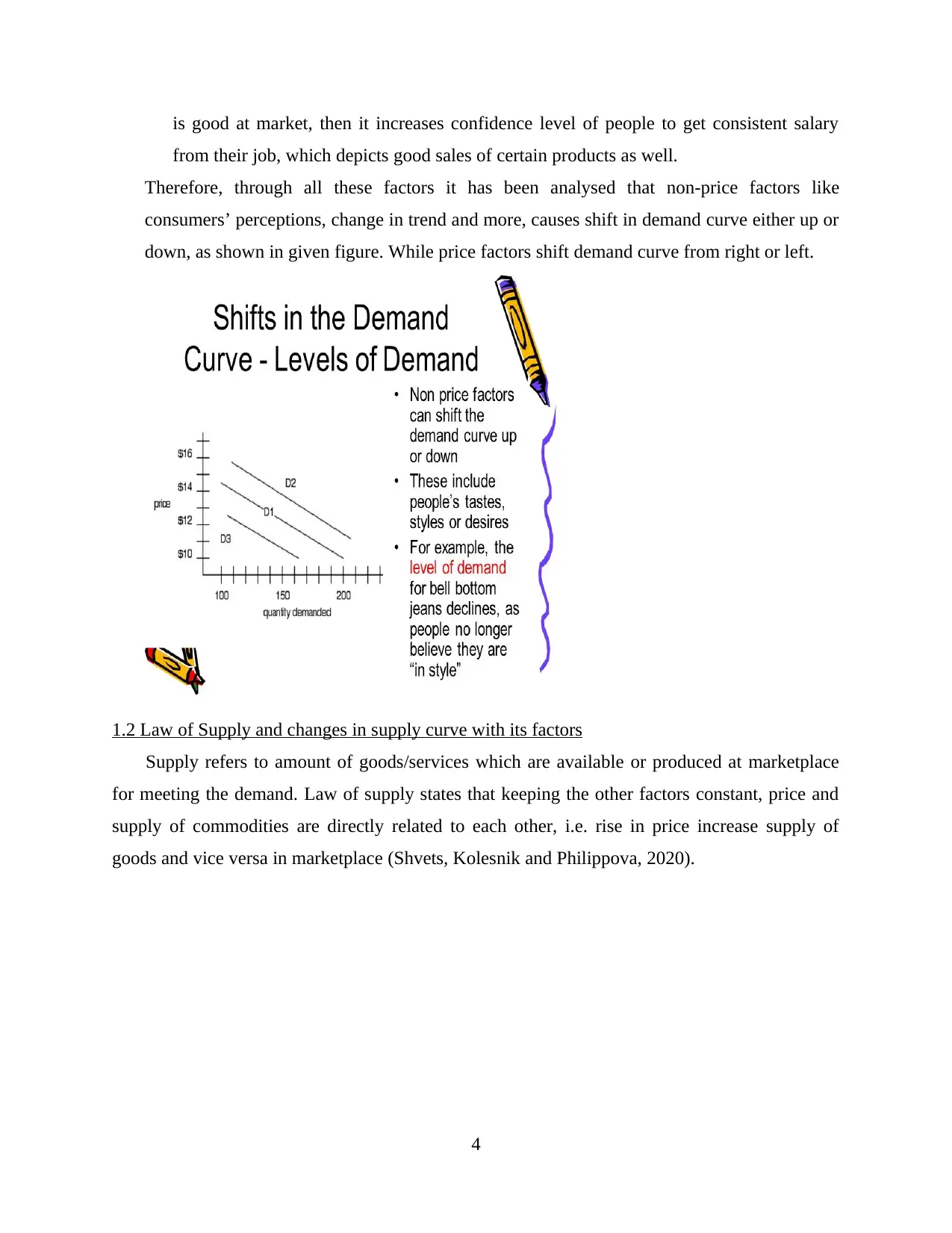
is good at market, then it increases confidence level of people to get consistent salary
from their job, which depicts good sales of certain products as well.
Therefore, through all these factors it has been analysed that non-price factors like
consumers’ perceptions, change in trend and more, causes shift in demand curve either up or
down, as shown in given figure. While price factors shift demand curve from right or left.
1.2 Law of Supply and changes in supply curve with its factors
Supply refers to amount of goods/services which are available or produced at marketplace
for meeting the demand. Law of supply states that keeping the other factors constant, price and
supply of commodities are directly related to each other, i.e. rise in price increase supply of
goods and vice versa in marketplace (Shvets, Kolesnik and Philippova, 2020).
4
from their job, which depicts good sales of certain products as well.
Therefore, through all these factors it has been analysed that non-price factors like
consumers’ perceptions, change in trend and more, causes shift in demand curve either up or
down, as shown in given figure. While price factors shift demand curve from right or left.
1.2 Law of Supply and changes in supply curve with its factors
Supply refers to amount of goods/services which are available or produced at marketplace
for meeting the demand. Law of supply states that keeping the other factors constant, price and
supply of commodities are directly related to each other, i.e. rise in price increase supply of
goods and vice versa in marketplace (Shvets, Kolesnik and Philippova, 2020).
4
Paraphrase This Document
Need a fresh take? Get an instant paraphrase of this document with our AI Paraphraser
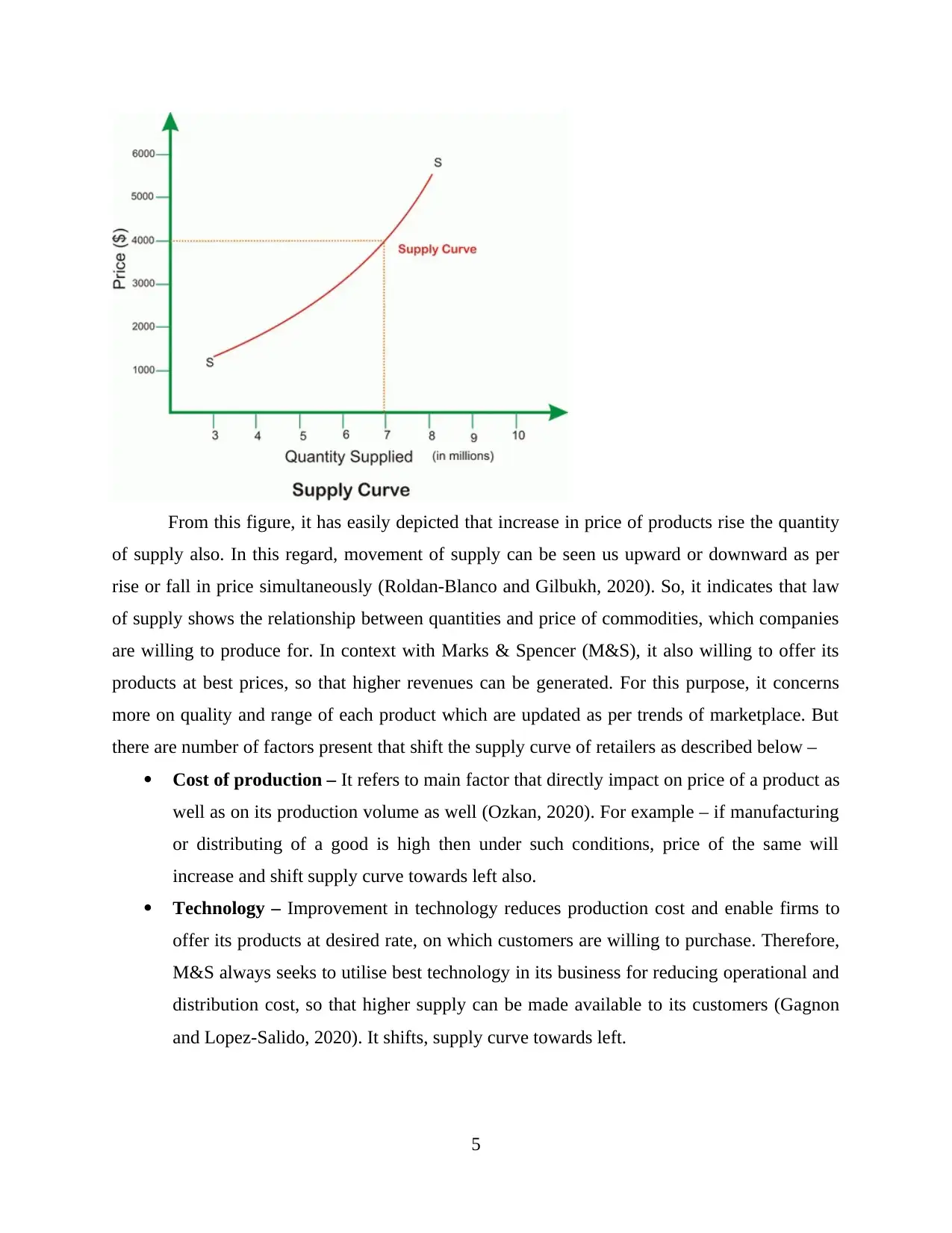
From this figure, it has easily depicted that increase in price of products rise the quantity
of supply also. In this regard, movement of supply can be seen us upward or downward as per
rise or fall in price simultaneously (Roldan-Blanco and Gilbukh, 2020). So, it indicates that law
of supply shows the relationship between quantities and price of commodities, which companies
are willing to produce for. In context with Marks & Spencer (M&S), it also willing to offer its
products at best prices, so that higher revenues can be generated. For this purpose, it concerns
more on quality and range of each product which are updated as per trends of marketplace. But
there are number of factors present that shift the supply curve of retailers as described below –
Cost of production – It refers to main factor that directly impact on price of a product as
well as on its production volume as well (Ozkan, 2020). For example – if manufacturing
or distributing of a good is high then under such conditions, price of the same will
increase and shift supply curve towards left also.
Technology – Improvement in technology reduces production cost and enable firms to
offer its products at desired rate, on which customers are willing to purchase. Therefore,
M&S always seeks to utilise best technology in its business for reducing operational and
distribution cost, so that higher supply can be made available to its customers (Gagnon
and Lopez-Salido, 2020). It shifts, supply curve towards left.
5
of supply also. In this regard, movement of supply can be seen us upward or downward as per
rise or fall in price simultaneously (Roldan-Blanco and Gilbukh, 2020). So, it indicates that law
of supply shows the relationship between quantities and price of commodities, which companies
are willing to produce for. In context with Marks & Spencer (M&S), it also willing to offer its
products at best prices, so that higher revenues can be generated. For this purpose, it concerns
more on quality and range of each product which are updated as per trends of marketplace. But
there are number of factors present that shift the supply curve of retailers as described below –
Cost of production – It refers to main factor that directly impact on price of a product as
well as on its production volume as well (Ozkan, 2020). For example – if manufacturing
or distributing of a good is high then under such conditions, price of the same will
increase and shift supply curve towards left also.
Technology – Improvement in technology reduces production cost and enable firms to
offer its products at desired rate, on which customers are willing to purchase. Therefore,
M&S always seeks to utilise best technology in its business for reducing operational and
distribution cost, so that higher supply can be made available to its customers (Gagnon
and Lopez-Salido, 2020). It shifts, supply curve towards left.
5
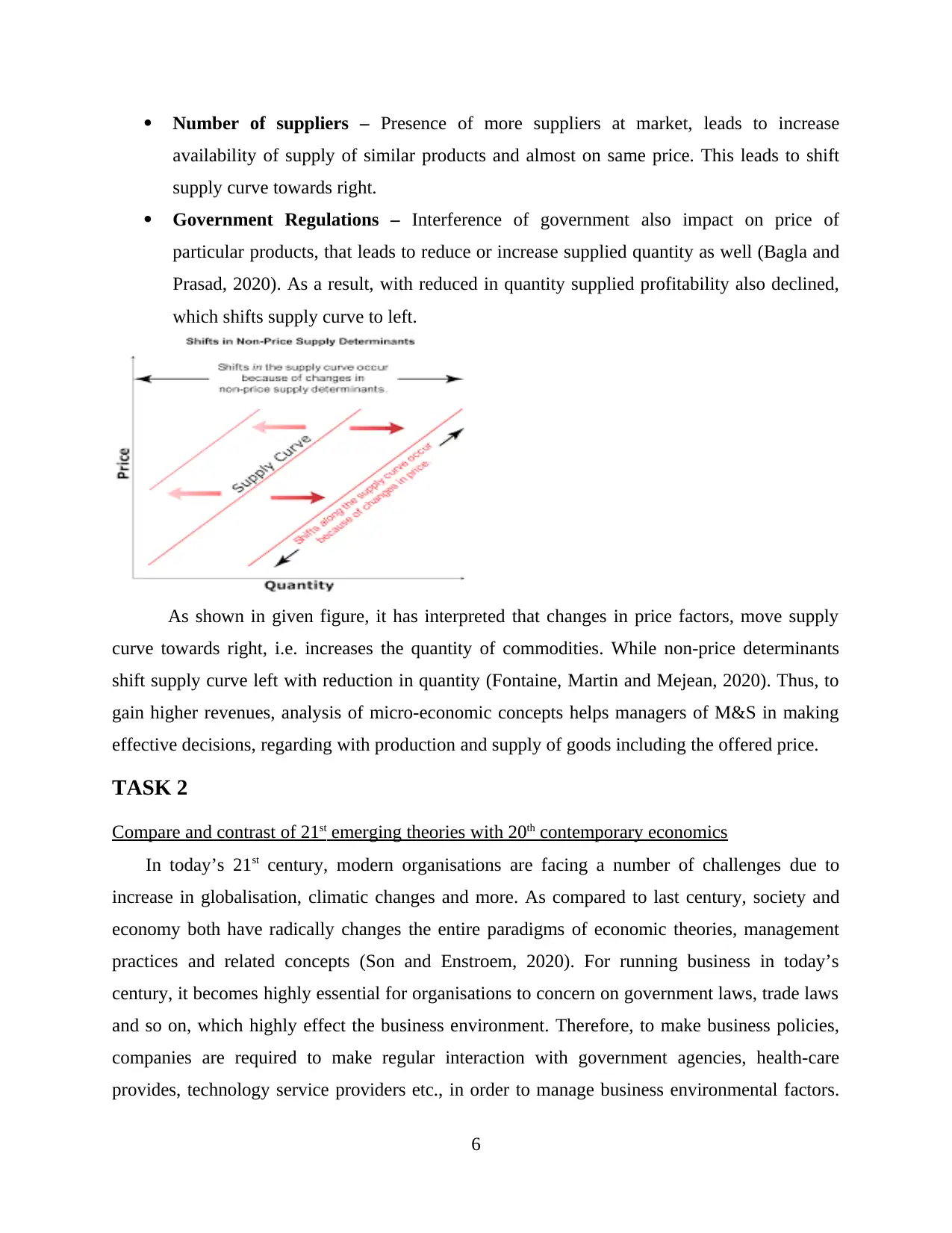
Number of suppliers – Presence of more suppliers at market, leads to increase
availability of supply of similar products and almost on same price. This leads to shift
supply curve towards right.
Government Regulations – Interference of government also impact on price of
particular products, that leads to reduce or increase supplied quantity as well (Bagla and
Prasad, 2020). As a result, with reduced in quantity supplied profitability also declined,
which shifts supply curve to left.
As shown in given figure, it has interpreted that changes in price factors, move supply
curve towards right, i.e. increases the quantity of commodities. While non-price determinants
shift supply curve left with reduction in quantity (Fontaine, Martin and Mejean, 2020). Thus, to
gain higher revenues, analysis of micro-economic concepts helps managers of M&S in making
effective decisions, regarding with production and supply of goods including the offered price.
TASK 2
Compare and contrast of 21st emerging theories with 20th contemporary economics
In today’s 21st century, modern organisations are facing a number of challenges due to
increase in globalisation, climatic changes and more. As compared to last century, society and
economy both have radically changes the entire paradigms of economic theories, management
practices and related concepts (Son and Enstroem, 2020). For running business in today’s
century, it becomes highly essential for organisations to concern on government laws, trade laws
and so on, which highly effect the business environment. Therefore, to make business policies,
companies are required to make regular interaction with government agencies, health-care
provides, technology service providers etc., in order to manage business environmental factors.
6
availability of supply of similar products and almost on same price. This leads to shift
supply curve towards right.
Government Regulations – Interference of government also impact on price of
particular products, that leads to reduce or increase supplied quantity as well (Bagla and
Prasad, 2020). As a result, with reduced in quantity supplied profitability also declined,
which shifts supply curve to left.
As shown in given figure, it has interpreted that changes in price factors, move supply
curve towards right, i.e. increases the quantity of commodities. While non-price determinants
shift supply curve left with reduction in quantity (Fontaine, Martin and Mejean, 2020). Thus, to
gain higher revenues, analysis of micro-economic concepts helps managers of M&S in making
effective decisions, regarding with production and supply of goods including the offered price.
TASK 2
Compare and contrast of 21st emerging theories with 20th contemporary economics
In today’s 21st century, modern organisations are facing a number of challenges due to
increase in globalisation, climatic changes and more. As compared to last century, society and
economy both have radically changes the entire paradigms of economic theories, management
practices and related concepts (Son and Enstroem, 2020). For running business in today’s
century, it becomes highly essential for organisations to concern on government laws, trade laws
and so on, which highly effect the business environment. Therefore, to make business policies,
companies are required to make regular interaction with government agencies, health-care
provides, technology service providers etc., in order to manage business environmental factors.
6
⊘ This is a preview!⊘
Do you want full access?
Subscribe today to unlock all pages.

Trusted by 1+ million students worldwide
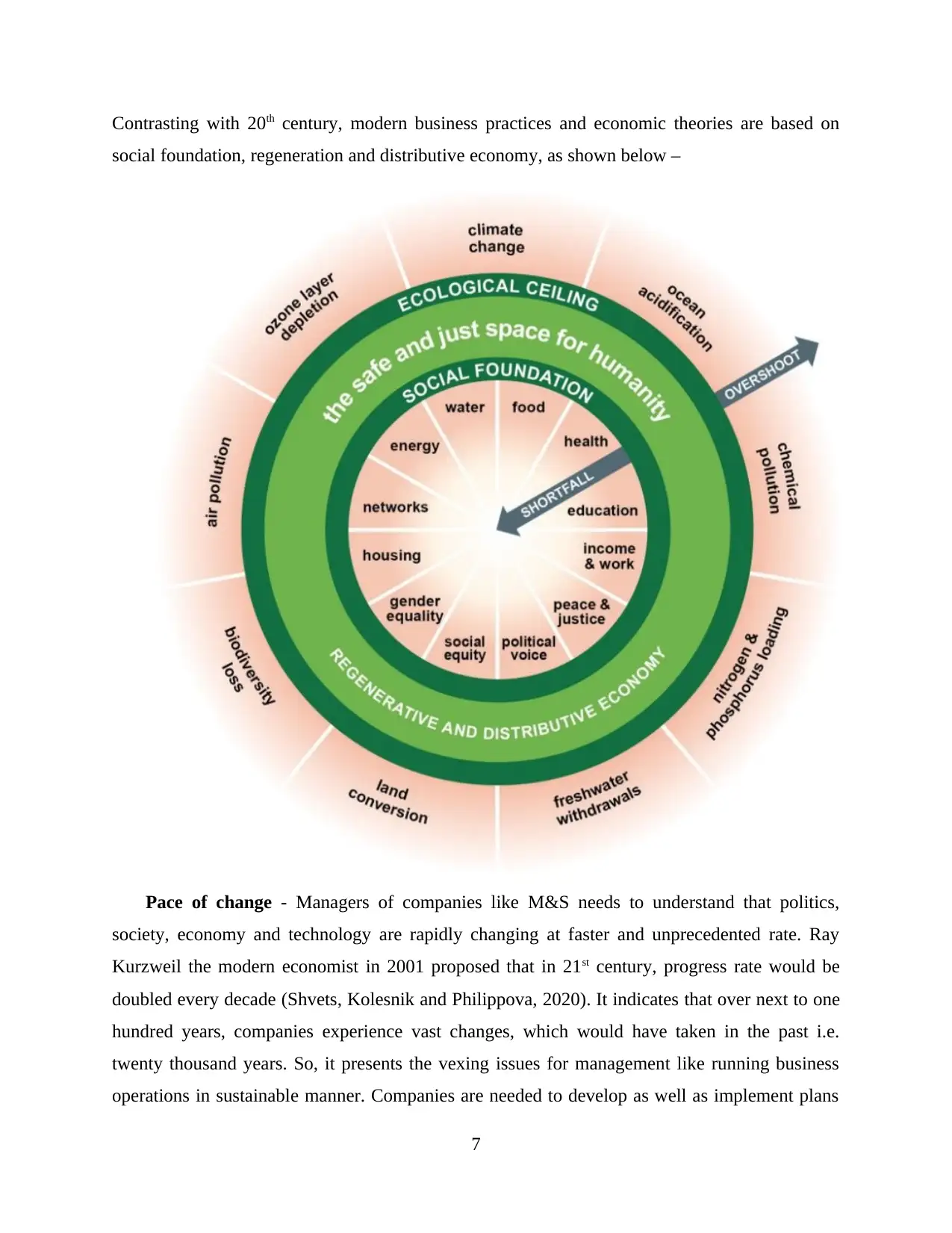
Contrasting with 20th century, modern business practices and economic theories are based on
social foundation, regeneration and distributive economy, as shown below –
Pace of change - Managers of companies like M&S needs to understand that politics,
society, economy and technology are rapidly changing at faster and unprecedented rate. Ray
Kurzweil the modern economist in 2001 proposed that in 21st century, progress rate would be
doubled every decade (Shvets, Kolesnik and Philippova, 2020). It indicates that over next to one
hundred years, companies experience vast changes, which would have taken in the past i.e.
twenty thousand years. So, it presents the vexing issues for management like running business
operations in sustainable manner. Companies are needed to develop as well as implement plans
7
social foundation, regeneration and distributive economy, as shown below –
Pace of change - Managers of companies like M&S needs to understand that politics,
society, economy and technology are rapidly changing at faster and unprecedented rate. Ray
Kurzweil the modern economist in 2001 proposed that in 21st century, progress rate would be
doubled every decade (Shvets, Kolesnik and Philippova, 2020). It indicates that over next to one
hundred years, companies experience vast changes, which would have taken in the past i.e.
twenty thousand years. So, it presents the vexing issues for management like running business
operations in sustainable manner. Companies are needed to develop as well as implement plans
7
Paraphrase This Document
Need a fresh take? Get an instant paraphrase of this document with our AI Paraphraser
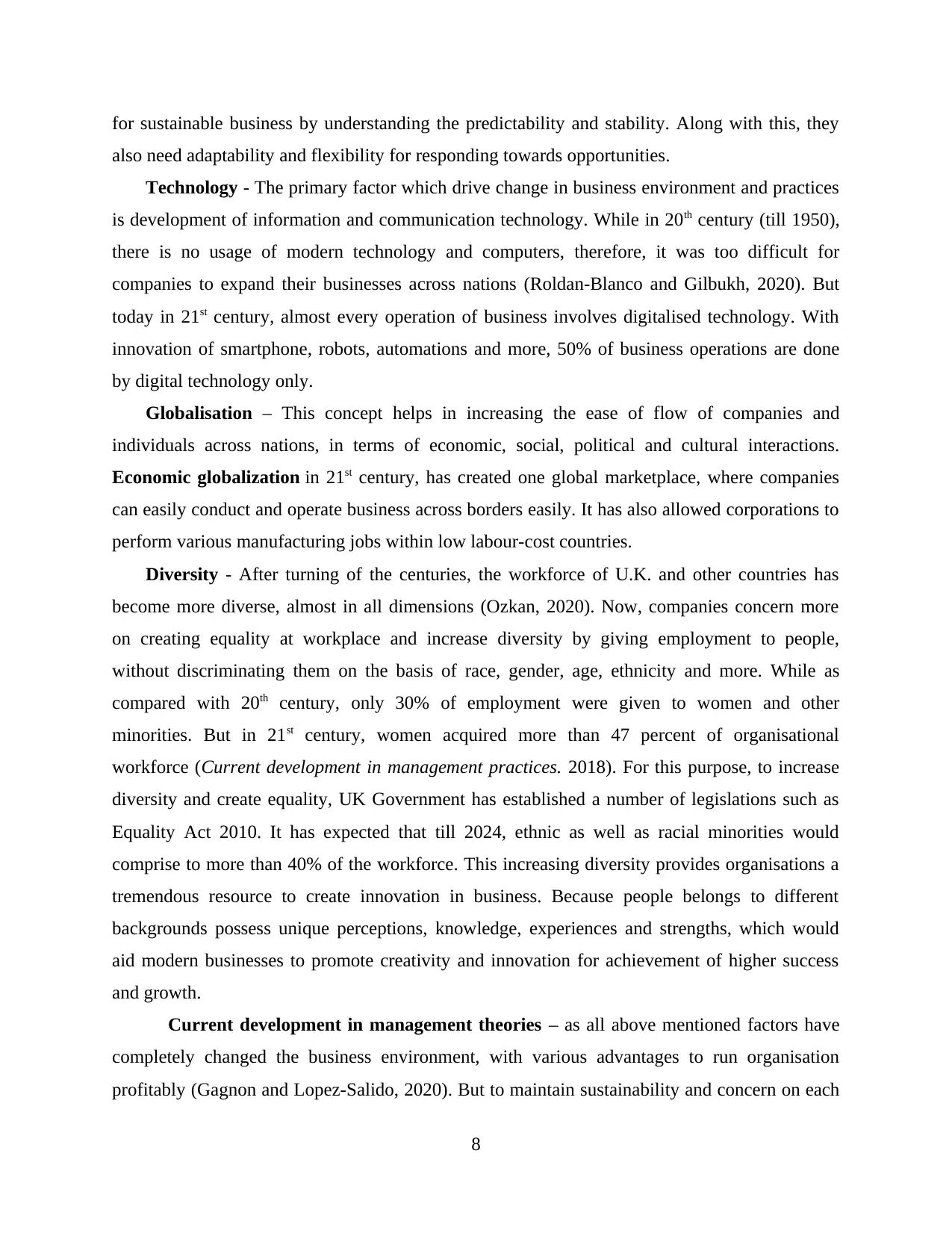
for sustainable business by understanding the predictability and stability. Along with this, they
also need adaptability and flexibility for responding towards opportunities.
Technology - The primary factor which drive change in business environment and practices
is development of information and communication technology. While in 20th century (till 1950),
there is no usage of modern technology and computers, therefore, it was too difficult for
companies to expand their businesses across nations (Roldan-Blanco and Gilbukh, 2020). But
today in 21st century, almost every operation of business involves digitalised technology. With
innovation of smartphone, robots, automations and more, 50% of business operations are done
by digital technology only.
Globalisation – This concept helps in increasing the ease of flow of companies and
individuals across nations, in terms of economic, social, political and cultural interactions.
Economic globalization in 21st century, has created one global marketplace, where companies
can easily conduct and operate business across borders easily. It has also allowed corporations to
perform various manufacturing jobs within low labour-cost countries.
Diversity - After turning of the centuries, the workforce of U.K. and other countries has
become more diverse, almost in all dimensions (Ozkan, 2020). Now, companies concern more
on creating equality at workplace and increase diversity by giving employment to people,
without discriminating them on the basis of race, gender, age, ethnicity and more. While as
compared with 20th century, only 30% of employment were given to women and other
minorities. But in 21st century, women acquired more than 47 percent of organisational
workforce (Current development in management practices. 2018). For this purpose, to increase
diversity and create equality, UK Government has established a number of legislations such as
Equality Act 2010. It has expected that till 2024, ethnic as well as racial minorities would
comprise to more than 40% of the workforce. This increasing diversity provides organisations a
tremendous resource to create innovation in business. Because people belongs to different
backgrounds possess unique perceptions, knowledge, experiences and strengths, which would
aid modern businesses to promote creativity and innovation for achievement of higher success
and growth.
Current development in management theories – as all above mentioned factors have
completely changed the business environment, with various advantages to run organisation
profitably (Gagnon and Lopez-Salido, 2020). But to maintain sustainability and concern on each
8
also need adaptability and flexibility for responding towards opportunities.
Technology - The primary factor which drive change in business environment and practices
is development of information and communication technology. While in 20th century (till 1950),
there is no usage of modern technology and computers, therefore, it was too difficult for
companies to expand their businesses across nations (Roldan-Blanco and Gilbukh, 2020). But
today in 21st century, almost every operation of business involves digitalised technology. With
innovation of smartphone, robots, automations and more, 50% of business operations are done
by digital technology only.
Globalisation – This concept helps in increasing the ease of flow of companies and
individuals across nations, in terms of economic, social, political and cultural interactions.
Economic globalization in 21st century, has created one global marketplace, where companies
can easily conduct and operate business across borders easily. It has also allowed corporations to
perform various manufacturing jobs within low labour-cost countries.
Diversity - After turning of the centuries, the workforce of U.K. and other countries has
become more diverse, almost in all dimensions (Ozkan, 2020). Now, companies concern more
on creating equality at workplace and increase diversity by giving employment to people,
without discriminating them on the basis of race, gender, age, ethnicity and more. While as
compared with 20th century, only 30% of employment were given to women and other
minorities. But in 21st century, women acquired more than 47 percent of organisational
workforce (Current development in management practices. 2018). For this purpose, to increase
diversity and create equality, UK Government has established a number of legislations such as
Equality Act 2010. It has expected that till 2024, ethnic as well as racial minorities would
comprise to more than 40% of the workforce. This increasing diversity provides organisations a
tremendous resource to create innovation in business. Because people belongs to different
backgrounds possess unique perceptions, knowledge, experiences and strengths, which would
aid modern businesses to promote creativity and innovation for achievement of higher success
and growth.
Current development in management theories – as all above mentioned factors have
completely changed the business environment, with various advantages to run organisation
profitably (Gagnon and Lopez-Salido, 2020). But to maintain sustainability and concern on each
8
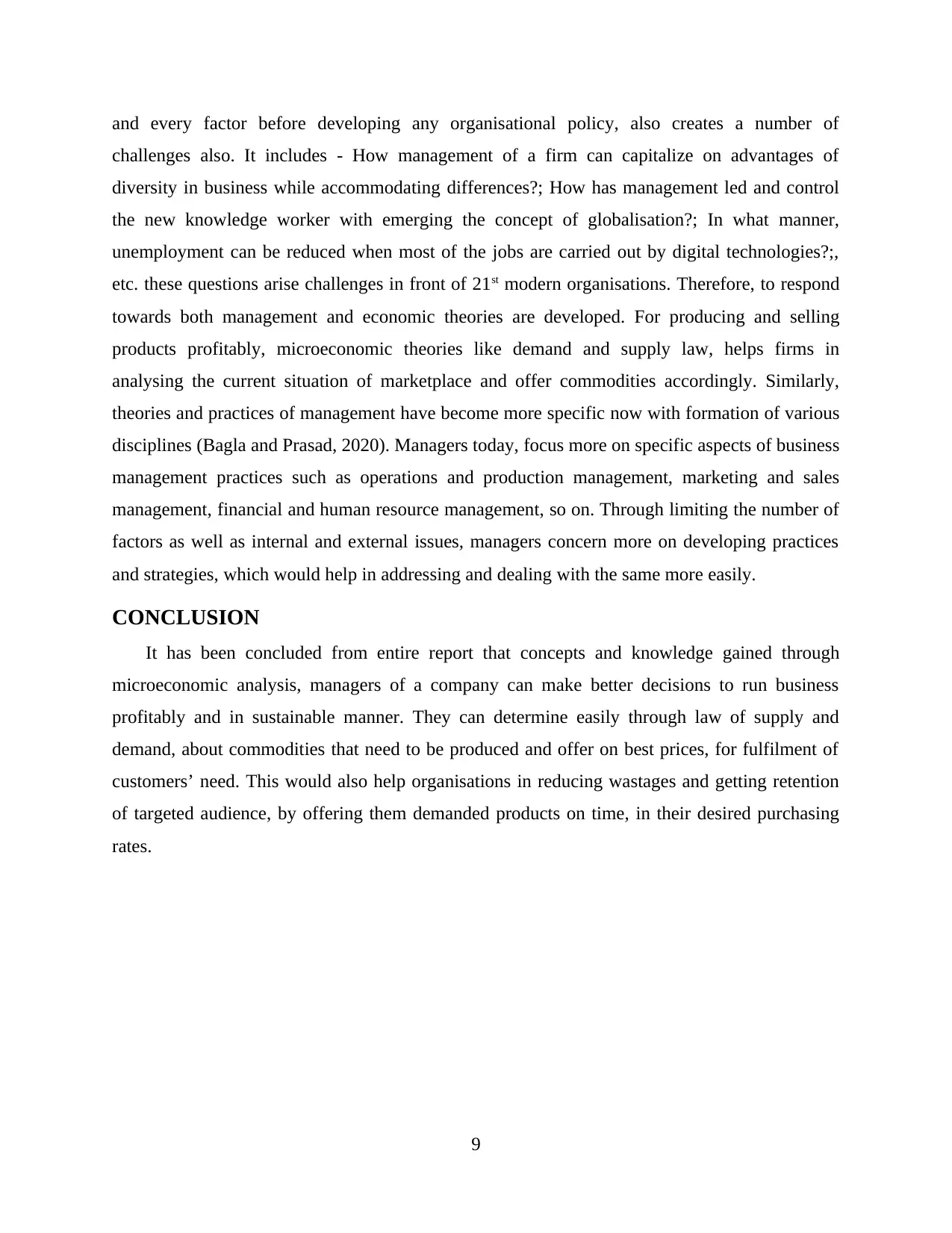
and every factor before developing any organisational policy, also creates a number of
challenges also. It includes - How management of a firm can capitalize on advantages of
diversity in business while accommodating differences?; How has management led and control
the new knowledge worker with emerging the concept of globalisation?; In what manner,
unemployment can be reduced when most of the jobs are carried out by digital technologies?;,
etc. these questions arise challenges in front of 21st modern organisations. Therefore, to respond
towards both management and economic theories are developed. For producing and selling
products profitably, microeconomic theories like demand and supply law, helps firms in
analysing the current situation of marketplace and offer commodities accordingly. Similarly,
theories and practices of management have become more specific now with formation of various
disciplines (Bagla and Prasad, 2020). Managers today, focus more on specific aspects of business
management practices such as operations and production management, marketing and sales
management, financial and human resource management, so on. Through limiting the number of
factors as well as internal and external issues, managers concern more on developing practices
and strategies, which would help in addressing and dealing with the same more easily.
CONCLUSION
It has been concluded from entire report that concepts and knowledge gained through
microeconomic analysis, managers of a company can make better decisions to run business
profitably and in sustainable manner. They can determine easily through law of supply and
demand, about commodities that need to be produced and offer on best prices, for fulfilment of
customers’ need. This would also help organisations in reducing wastages and getting retention
of targeted audience, by offering them demanded products on time, in their desired purchasing
rates.
9
challenges also. It includes - How management of a firm can capitalize on advantages of
diversity in business while accommodating differences?; How has management led and control
the new knowledge worker with emerging the concept of globalisation?; In what manner,
unemployment can be reduced when most of the jobs are carried out by digital technologies?;,
etc. these questions arise challenges in front of 21st modern organisations. Therefore, to respond
towards both management and economic theories are developed. For producing and selling
products profitably, microeconomic theories like demand and supply law, helps firms in
analysing the current situation of marketplace and offer commodities accordingly. Similarly,
theories and practices of management have become more specific now with formation of various
disciplines (Bagla and Prasad, 2020). Managers today, focus more on specific aspects of business
management practices such as operations and production management, marketing and sales
management, financial and human resource management, so on. Through limiting the number of
factors as well as internal and external issues, managers concern more on developing practices
and strategies, which would help in addressing and dealing with the same more easily.
CONCLUSION
It has been concluded from entire report that concepts and knowledge gained through
microeconomic analysis, managers of a company can make better decisions to run business
profitably and in sustainable manner. They can determine easily through law of supply and
demand, about commodities that need to be produced and offer on best prices, for fulfilment of
customers’ need. This would also help organisations in reducing wastages and getting retention
of targeted audience, by offering them demanded products on time, in their desired purchasing
rates.
9
⊘ This is a preview!⊘
Do you want full access?
Subscribe today to unlock all pages.

Trusted by 1+ million students worldwide
1 out of 13
Related Documents
Your All-in-One AI-Powered Toolkit for Academic Success.
+13062052269
info@desklib.com
Available 24*7 on WhatsApp / Email
![[object Object]](/_next/static/media/star-bottom.7253800d.svg)
Unlock your academic potential
Copyright © 2020–2025 A2Z Services. All Rights Reserved. Developed and managed by ZUCOL.



